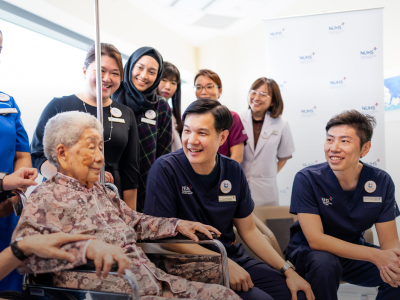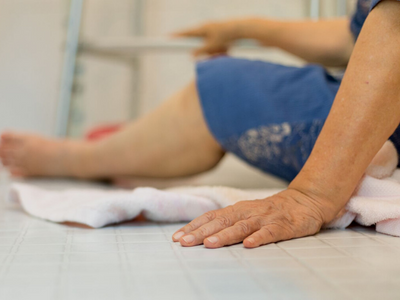Published on 9 August 2022
For seniors, waist circumference may be a better indicator of health than the conventionally-used BMI, says geriatrician A/Prof Reshma Merchant.
Over the past 200 years, Body Mass Index (BMI) has become a ubiquitous presence in hospitals around the world.
Part of its massive influence, perhaps, lies in its simplicity: weight over height. This screening tool allows physicians to diagnose obesity quickly and easily.
While a useful population-level tool, BMI has its downsides. It can’t account for where the fat sits on the body, for instance; and importantly, it can’t differentiate between fat and muscle.
This poses a particular problem for seniors, who have a different fat distribution as compared to the rest of the population, said geriatrician A/Prof Reshma Merchant.
“The thing about ageing is that a lot of [the issue] is with visceral fat, not overall fat,” she explained. Visceral fat is fat that is stored deep inside the belly and around the organs. Linked to higher risk of chronic disease, it tends to accumulate around the gut, causing the appearance of a ‘beer belly’.
“So the question is: wouldn’t it make more sense if we look at the waistline instead?
The problem with BMI
People shrink as they age. It’s a common enough phenomenon, and it’s caused by a variety of factors – osteoporosis, for instance, or simple wear and tear to the bones and cartilage.
As such, with age, BMI – which measures weight over height – may increase, even if the patient isn’t actually putting on weight.
“Quite a few of my patients come to me and say, ‘oh, I’m fat, my BMI is 25’,” explained A/Prof Merchant, who heads the Division of Geriatric Medicine at the National University Hospital (NUH). “But [in older patients], BMI is not really accurate.”
Aside from being potentially misleading, a fixation on BMI could be dangerous, she added. This is because patients tend to focus on weight loss, without differentiating fat from muscle, and end up inadvertently losing muscle mass as well.
While this might not seem like a particularly severe side effect for most people, losing muscle mass can have devastating consequences on the geriatric population, shared A/Prof Merchant.
For one, a lack of muscle mass in the limbs can lead to difficulties walking steadily. This, in turn, encourages patients to walk and exercise less, and end up losing even more muscle mass. “It’s a chicken and egg situation,” she said.
Low muscle mass also causes frailty, which is in turn associated with a whole host of other problems, such as increased risk of falls.
Worse, once the muscle mass is lost in older adults, it is very hard to rebuild. As a result, indiscriminate weight loss may end up with the patient’s health permanently crippled.
Among older patients, “[muscle mass loss] is actually a very, very, very common problem,” she said. “The minute you start losing weight, you just become way more frail.”
“And when we see them in the hospital and the clinic, they’re often already quite frail, they’ve fallen, they have a limited quality of life…and [this] really prompted me to see how we can move this upstream, before they even reach this stage.”
Central obesity: a better, safer assessment tool
It was this observation – older patients compromising their own health in a bid to obtain a ‘healthy’ BMI – that persuaded A/Prof Merchant to investigate a different, potentially safer indicator of obesity: waist circumference.
Waist circumference is a measure of central obesity, a factor reflective of visceral fat. In recent years, central obesity has been gaining popularity as an indicator of health, with multiple studies comparing it favourably to BMI.
However, few studies so far have focused on seniors, said A/Prof Merchant – an information gap that she sought to fill.
Published in December 2021, A/Prof Merchant’s study surveyed 754 participants aged 65 years and above. Among its findings, the study showed that patients with central obesity, regardless of their BMI, were more likely to suffer from chronic diseases like hypertension and diabetes – even if they were underweight.
As to how to go about that, she recommends a mixture of “the right kinds” of exercise – such as resistance exercises – that can reduce waist circumference, while also maintaining and building muscle strength. Diet-wise, A/Prof Merchant recommends consuming sufficient protein if there are no medical contraindication: at least a palm-sized amount with each meal.
“A lot of the patients that we see in our clinic – they love hawker food, [which may not have adequate nutrition],” she shared. “Or sometimes to save money, they eat rice and vegetables, or just porridge.”
Because of hormonal changes that come with age, an unbalanced diet can lead to fat being deposited inside and between the muscle. This can cause inflammation and can be damaging to muscle, leading to more muscle loss and even conditions like osteoarthritis.
Ultimately, an ideal approach aims to reduce fat gain while putting emphasis on building and retaining muscle.
And this is advice that A/Prof Merchant herself intends to take, as she approaches the latter half of middle age.
“The World Health Organisation defines healthy ageing as maintaining adequate function and cognition,” she said. “We do decline with age, but there are ways to remain functional.”
“[But] if we don’t focus on muscle mass from an early age …we’ll eventually come to a stage where lost muscle mass is very, very hard to rebuild.
In consultation with A/Prof Reshma Merchant, Head & Senior Consultant, Division of Geriatric Medicine, Department of Medicine, NUH and Associate Professor, Department of Medicine, NUS Medicine, Yong Loo Lin School of Medicine, National University of Singapore.
Download the full infographics here.




